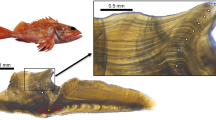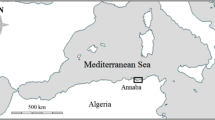Abstract
Accurate age estimates are key life history parameters for understanding growth, reproduction and susceptibility to exploitation. Using a combination of fin spine growth increments and bomb radiocarbon dating, we provide minimum age estimates for the small Atlantic squaloid shark, black dogfish (Centroscyllium fabricii) sampled in Greenland waters. Age estimates based on growth increments in the fin spine, just distal to the end of the pulp cavity, were obtained from males (N = 64) and females (N = 70), and von Bertalanffy growth curves were fitted. The maximum growth increment count was 36 in males and 35 in females. Males and females had similar growth rates, but females grew larger (Linf, females = 68 cm, Linf, males = 61 cm). To evaluate the fin spine age estimates, bomb radiocarbon dating on eye lenses were done on a selection of females. All individuals larger than 65 cm (total length) were older than the bomb pulse corresponding to an age of at least 53 years, while those smaller than 55 cm were younger. Therefore, we observe a discrepancy between age estimates obtained from fin spines and bomb radiocarbon dating, indicating that fin spines are unsuitable for ageing black dogfish, at least for the oldest individuals.





Similar content being viewed by others
References
Bassnett S, Shi Y, Vrensen GFJM (2011) Biological glass: structural determinants of eye lens transparency. Philos Trans Biol Sci 366:1250–1264
Beamish RJ, McFarlane G (1985) Annulus development on the second dorsal spine of the spiny dogfish (Squalus acanthias) and its validity for age determination. Can J Fish Aquat Sci 42:1799–1805
Beamish RJ, McFarlane G (2000) Reevaluation of the interpretation of annuli from otoliths of a long-lived fish, Anoplopoma fimbria. Fish Res 46:105–111. https://doi.org/10.1016/S0165-7836(00)00137-5
Campana SE (2001) Accuracy, precision and quality control in age determination, including a review of the use and abuse of age validation methods. J Fish Biol 59:197–242. https://doi.org/10.1006/jfbi.2001.1668
Campana SE, Jones C, Mcfarlane GA, Myklevoll S (2006) Bomb dating and age validation using the spines of spiny dogfish (Squalus acanthias). Environ Biol Fishes 77:327–336. https://doi.org/10.1007/s10641-006-9107-3
Campana SE, Natanson LJ, Myklevoll S (2002) Bomb dating and age determination of large pelagic sharks. Can J Fish Aquat Sci 59:450–455. https://doi.org/10.1139/F02-027
Campana SE, Valentin EV, MacLellan SE, Groot JB (2016) Image-enhanced burnt otoliths, bomb radiocarbon and the growth dynamics of redfish (Sebastes mentella and S. fasciatus) off the eastern coast of Canada. Mar Freshw Res 67:925–936
Clarke MW, Connolly PL, Bracken JJ (2002) Age estimation of the exploited deepwater shark Centrophorus squamosus from the continental slopes of the Rockall Trough and Porcupine Bank. J Fish Biol 60:501–514. https://doi.org/10.1006/jfbi.2001.1861
De Vries H (1958) Atomic bomb effect: variation of radiocarbon in plants, shells, and snails in the past 4 years. Science 128:250–251
Freer DWL, Griffiths CL (1993) Estimation of age and growth in the St Joseph Callorhinchus capensis (Dumeril). Afr J Mar Sci 13:75–81. https://doi.org/10.2989/025776193784287194
Garde E, Heide-Jorgensen MP, Hansen SH et al (2007) Age-specific growth and remarkable longevity in narwhals (Monodon monoceros) from west greenland as estimated by aspartic acid racemization. J Mammal 88:49–58
George JC, Bada J, Zeh J et al (1999) Age and growth estimates of bowhead whales (Balaena mysticetus) via aspartic acid racemization. Can J Zool 77:571–580. https://doi.org/10.1139/cjz-77-4-571
Hamady LL, Natanson LJ, Skomal GB, Thorrold SR (2014) Vertebral bomb radiocarbon suggests extreme longevity in white sharks. PLoS ONE 9:1–8. https://doi.org/10.1371/journal.pone.0084006
Harry AV (2018) Evidence for systemic age underestimation in shark and ray ageing studies. Fish Fish 19:185–200. https://doi.org/10.1111/faf.12243
Hedeholm R, Qvist T, Nielsen J, Grønkjær P (2019) Temporal changes in size-at-maturity of black dogfish Centroscyllium fabricii. J Fish Biol. https://doi.org/10.1111/jfb.14072
Hoenig JM, Gruber SH (1990) Life history patterns in the elasmobranchs: implications for fisheries management. In: Elasmobranchs as living resources: advances in the biology, ecology, systematics and the status of the fisheries. NOAA technical report 90. pp 1–16
Holden MJ, Meadows PS (1962) The structure of the spine of spur dogfish (Squalus acanthias L.) and its use for age determination. J Mar Biol Assoc 42:179–197
ICES (2018) Report of the working group on elasmobranch fishes (WGEF), 19–28 June 2018, Lisbon, Portugal. ICES CM 2018/ACOM: 16, p. 1306.
Jakobsdóttir KB (2001) Biological aspects of two deep-water squalid sharks: Centroscyllium fabricii (Reinhardt, 1825) and Etmopterus princeps (Collett, 1904) in Icelandic waters. Fish Res 51:247–265. https://doi.org/10.1016/S0165-7836(01)00250-8
Jørgensen OA, Bastardie F, Eigaard OR (2014) Impact of deep-sea fishery for Greenland halibut (Reinhardtius hippoglossoides) on non-commercial fish species off West Greenland. ICES J Mar Sci 71:845–852. https://doi.org/10.1093/icesjms/fst191
Ketchen KS (1975) Age and growth of dogfish Squalus acanthias in British Columbia Waters. J Fish Res Board Canada 32:43–59. https://doi.org/10.1139/f75-006
Lynnerup N, Kjeldsen H, Heegaard S et al (2008) Radiocarbon dating of the human eye lens crystallines reveal proteins without carbon turnover throughout life. PLoS ONE 3:1–3. https://doi.org/10.1371/journal.pone.0001529
Nielsen J, Hedeholm RB, Heinemeier J et al (2016) Eye lens radiocarbon reveals centuries of longevity in the Greenland shark (Somniosus microcephalus). Science 353:702–704. https://doi.org/10.1126/science.aaf1703
Nielsen J (2018) The Greenland shark (Somniosus microcephalus) Diet, tracking and radiocarbon age estimates reveal the world’s oldest vertebrate. Ph.D. Thesis, University of Copenhagen.
Olsen EM, Heino M, Lilly GR et al (2004) Maturation trends indicative of rapid evolution preceded the collapse of northern cod. Nature 428:932–935. https://doi.org/10.1038/nature02453.1
Olsen JD, Tikhomirov C, Grosen J, Heinemeier J, Klein M (2016) Radiocarbon Analysis on the New AARAMS 1MV Tandetron. Radiocarbon: 1–9
Pearcy WG, Stuvier M (1983) Vertical transport of carbon-14 into deep-sea food webs. Deep-Sea Res 30(4A):427–440
Stuiver M, Polach HA (1977) Reporting of C-14 data. Radiocarbon 19:355–363
Qvist T (2017) Age estimates and distribution of the black dogfish (Centroscyllium fabricii ) M.Sc. Thesis, Aarhus University
Sullivan KJ (1977) Age ad growth of the elephant fish. callorhinchus milii (Elasmobranchii: Callorhynchidae. New Zeal J Mar Fresh 11:745–753. https://doi.org/10.1080/00288330.1977.9515710
Scourse JD, Wanamaker AD, Weidman C et al (2012) The marine radiocarbon bomb pulse across the temperate North Atlantic: a compilation of Δ14C time histories from Arctica islandica growth increments. Radiocarbon 54:165–186. https://doi.org/10.2458/azu_js_rc.v54i2.16026
Stevens MM, Andrews AH, Cailliet GM et al (2004) Radiometric validation of age, growth, and longevity for the blackgill rockfish (Sebastes melanostomus). Fish Bull 102:711–722
Stewart REA, Campana SE, Jones CM, Stewart BE (2006) Bomb radiocarbon dating calibrates beluga (Delphinapterus leucas) age estimates. Can J Zool 84:1840–1852
Treble MA, Campana SE, Wastle RJ et al (2008) Growth analysis and age validation of a deepwater Arctic fish, the Greenland halibut (Reinhardtius hippoglossoides). Can J Fish Aquat Sci 65:1047–1059. https://doi.org/10.1139/F08-030
Trippel EA (1995) Age at maturity as a stress indicator in fisheries. Bioscience 45:759. https://doi.org/10.2307/1312628
Williams PM, Druffel ERM, Smith KL Jr (1987) Dietary carbon sources for deep-sea organisms as inferred from their organic radiocarbon activities. Deep-Sea Res 34(2):253–266
Williams PM, McGowan JA, Stuvier M (1970) Bomb carbon-14 in deep ocean sea organisms. Nature 227:375–376
Worm B, Davis B, Kettemer L et al (2013) Global catches, exploitation rates, and rebuilding options for sharks. Mar Policy 40:194–204. https://doi.org/10.1016/j.marpol.2012.12.034
Yano K (1995) Reproductive biology of the Black dogfish, Centroscyllium fabricii, collected from waters off Western Greenland. J Mar Biol Assoc UK 75:285–310
Acknowledgements
The authors wish to thank three reviewers for their effort and comments that improved the manuscript throughout.
Author information
Authors and Affiliations
Contributions
RH designed the study, secured funding and was the primary author of the manuscript. TQ conducted laboratory work and co-analysed data. MF conducted laboratory work and co-analysed data. JO conducted the work related to radiocarbon dating and analysed those data. JN designed the study and co-wrote the primary text. PG co-funded the study and analysed the data. All authors contributed with text and review of earlier manuscript drafts.
Corresponding author
Ethics declarations
Conflict of interest
The authors declare that they have no conflict of interest.
Ethical approval
All specimens included in this study were caught as part of a standardized scientific survey conducted by the Greenland Institute of Natural Resources. The survey does not target black dogfish, but these are an unavoidable bycatch. All sampling followed the institutional guidelines that are in agreement with international standards and follow a strict protocol of the highest ethical standard.
Additional information
Publisher's Note
Springer Nature remains neutral with regard to jurisdictional claims in published maps and institutional affiliations.
Supplementary Information
Below is the link to the electronic supplementary material.
Rights and permissions
About this article
Cite this article
Hedeholm, R., Qvist, T., Frausing, M. et al. Age of black dogfish (Centroscyllium fabricii) estimated from fin spines growth bands and eye lens bomb radiocarbon dating. Polar Biol 44, 751–759 (2021). https://doi.org/10.1007/s00300-021-02832-5
Received:
Revised:
Accepted:
Published:
Issue Date:
DOI: https://doi.org/10.1007/s00300-021-02832-5




